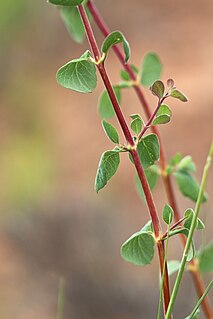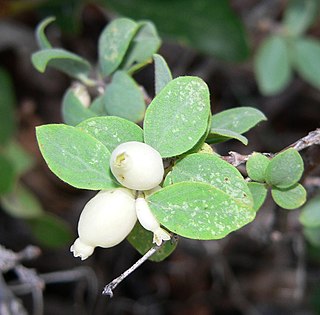
Symphoricarpos, commonly known as the snowberry, waxberry, or ghostberry, is a small genus of about 15 species of deciduous shrubs in the honeysuckle family, Caprifoliaceae. With the exception of the Chinese coralberry, S. sinensis, which is indigenous to western China, all species are native to North and Central America. The name of the genus is derived from the Ancient Greek words συμφορεῖν (sumphoreîn), meaning "to bear together", and καρπός (karpós), meaning "fruit". It refers to the closely packed clusters of berries the species produce.

The only species in the monotypic genus Achyrachaena is the annual herb Achyrachaena mollis, which bears the common name blow-wives. The genus name is both singular and plural.

Vaccinium ovatum is a North American species of flowering shrub known by the common names evergreen huckleberry,winter huckleberry and California huckleberry.
Creeping snowberry is a common name for several plants and may refer to:

Symphoricarpos occidentalis, commonly called western snowberry or wolfberry, is a woody species of flowering plant in the honeysuckle family. Wolfberry is not to be confused with Lycium chinense and L. barbarum (goji), which are also known as wolfberry.

Symphoricarpos orbiculatus, commonly called coralberry, buckbrush or Indian currant is a woody species of flowering plant in the honeysuckle family.

Symphoricarpos albus is a species of flowering plant in the honeysuckle family known by the common name common snowberry. It is native to North America, where it occurs across much of Canada and the northern and western United States.

Symphoricarpos longiflorus is a species of flowering plant in the honeysuckle family known by the common names desert snowberry and fragrant snowberry. It is native to the western United States from the Great Basin to western Texas, as well as northwestern Mexico.

Symphoricarpos rotundifolius is a North American subshrub in the honeysuckle family, also known by the common name round-leaved snowberry.

Gaultheria hispidula, commonly known as the creeping snowberry or moxie-plum, is a perennial spreading ground-level vine of the heath family Ericaceae native to North America that produces small white edible berries. It fruits from August to September. Its leaves and berries taste and smell like wintergreen.

Physocarpus malvaceus is a species of flowering plant in the rose family known by the common name mallow ninebark. It is native to western North America, where its distribution extends from British Columbia to Nevada to Wyoming.

Symphoricarpos oreophilus is a North American species of flowering plant in the Caprifoliaceae, or honeysuckle family, known by the common name mountain snowberry. It has a wide distribution in western Canada, the United States, and northwestern Mexico. It is found in mountainous areas such as the Cascades, the Sierra Nevada, the Rockies, and the Sierra Madre Occidental from British Columbia to the Copper Canyon region of Chihuahua, from the coastal states as far inland as the Black Hills, the Oklahoma Panhandle, and trans-Pecos Texas.
Bird food plants are certain trees, shrubs and herbaceous plants bear fruits which afford food for birds. These have been discovered by observation, and by the scientific examination of the contents of birds' stomachs. By planting those species, therefore, which have been proved most desirable and that are suited to the climate and soil of the chosen location, birds can be attracted to the vicinity of dwelling houses or to any other desired spot as a copse or shrubbery, or, on the other hand, lured away from valuable orchards, since they appear to like best arid, bitter, sour or aromatic fruits, distasteful to human beings, even better than the cultivated kinds.
Symphoricarpos palmeri, common name Palmer's snowberry, is a North American species of plants in the Honeysuckle Family. It has been found in the southwestern United States, as well as in the Mexican State of Chihuahua inside Basaseachic Falls National Park.
Symphoricarpos hesperius, called the trailing snowberry or creeping snowberry, is a North American species of trailing shrubs in the honeysuckle family. It is native to southwestern Canada and the northwestern United States
Symphoricarpos acutus, the sharpleaf snowberry, is a North American species of trailing shrubs in the honeysuckle family. It is native to the western United States.
Symphoricarpos microphyllus, the pink snowberry, is a North American species of flowering plant in the honeysuckle family. It is widespread across much of Mexico from Chihuahua to Chiapas, and found also in Guatemala, Honduras, and the US State of New Mexico.
Symphoricarpos vaccinioides is a North American species of flowering plant in the honeysuckle family. It had been found in western Canada and in the western United States.
Symphoricarpos parishii, or Parish's snowberry, is a North American species of flowering plant in the honeysuckle family. It had been found in California, Nevada, Arizona, and Baja California.
Symphoricarpos guadalupensis, McKittrock's snowberry, is a rare North American species of plants in the honeysuckle family. It has been found only in South McKittrick Canyon in the Guadalupe Mountains of western Texas. This is inside Guadalupe Mountains National Park.


















